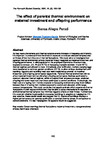The effect of parental thermal environment on maternal investment and offspring performance
| dc.contributor.author | Parodi, B.A. | |
| dc.date.accessioned | 2021-12-24T17:11:06Z | |
| dc.date.available | 2021-12-24T17:11:06Z | |
| dc.date.issued | 2021 | |
| dc.identifier.citation |
Parodi, B.A. (2021) 'The effect of parental thermal environment on maternal investment and offspring performance', The Plymouth Student Scientist, 14(2), pp. 128-139. | en_US |
| dc.identifier.uri | http://hdl.handle.net/10026.1/18501 | |
| dc.description.abstract |
As heat wave phenomena and thermal variance events increase in frequency and intensity, it is important to understand how the effect of exposure to constant elevated temperatures on fitness differs from the one of thermal fluctuations. This study aims to investigate how parental thermal environment affects maternal fitness measured as maternal investment and offspring performance. A wild population of the amphipod Gammarus chevreuxi was exposed to constant (15, 20 and 25 °C) or fluctuating (variable between 15 and 25 °C) thermal regimes and allowed to mate. Immediately after fertilization, mothers carrying eggs were transferred to common garden conditions (15 °C), to allow embryo development until hatching. Egg size and hatchling heart rate were measured as proxies for maternal investment and offspring performance respectively. Parental thermal environment did not affect maternal investment but did affect offspring performance. Mothers acclimated to constant, elevated thermal regimes, within or beyond their temperature range, produced offspring with lower heart rate than those acclimated to control conditions. Interestingly, the heart rate of offspring from mothers exposed to fluctuating environments was intermediate between that of offspring from mothers exposed to control and elevated, within range, constant temperatures. This study concludes that aquatic animals which experience thermal fluctuations in their natural environment may be able to adopt mechanisms in response to environmental thermal variance that minimise negative effects on their fitness. Furthermore, it is uncertain whether bradycardia in crustacea hatchlings is adaptive or maladaptive. If it was adaptive, these results would also suggest that G. chevreuxi hatchlings displays a higher performance after parental acclimation to constant thermal stress, in comparison to control conditions. If it was maladaptive the opposite would be suggested. | en_US |
| dc.language.iso | en | en_US |
| dc.publisher | University of Plymouth | en_US |
| dc.rights | Attribution 3.0 United States | * |
| dc.rights.uri | http://creativecommons.org/licenses/by/3.0/us/ | * |
| dc.subject | Ocean warming | en_US |
| dc.subject | thermal fluctuations | en_US |
| dc.subject | maternal investment | en_US |
| dc.subject | transgenerational effects | en_US |
| dc.subject | Gammarus chevreuxi | en_US |
| dc.title | The effect of parental thermal environment on maternal investment and offspring performance | en_US |
| dc.type | Article | en_US |
| plymouth.issue | 2 | |
| plymouth.volume | 14 | |
| plymouth.journal | The Plymouth Student Scientist |



